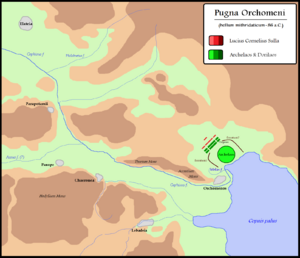Battle of Orchomenus facts for kids
Quick facts for kids Battle of Orchomenus |
|||||||
|---|---|---|---|---|---|---|---|
| Part of First Mithridatic War | |||||||
 |
|||||||
|
|||||||
| Belligerents | |||||||
| Roman Republic | Pontus | ||||||
| Commanders and leaders | |||||||
| Lucius Cornelius Sulla | Archelaus Dorylaeus |
||||||
| Strength | |||||||
| 30,000 | 75,000–80,000 | ||||||
| Casualties and losses | |||||||
| about 100 | heavy, suggested some 15,000 | ||||||
The Battle of Orchomenus was a major fight in 85 BC. It happened between the powerful Roman army and the forces of Mithridates VI of Pontus. The Roman side was led by Lucius Cornelius Sulla. Mithridates' army was commanded by Archelaus.
The Romans won this important battle. Archelaus later even joined the Roman side. This victory finally stopped Mithridates' invasion of Europe. You can read more about this battle in Plutarch's book, Life of Sulla.
Contents
Why the Battle Happened: The Background
After winning a battle at Chaeronea, Sulla was moving his army. He was heading towards a region called Thessaly. He planned to meet another Roman leader there.
Suddenly, Sulla heard surprising news. A general named Dorylaeus had arrived. He brought 80,000 of Mithridates' best soldiers by ship. These new troops were meant to help Archelaus.
Dorylaeus wanted to fight Sulla right away. Sulla quickly changed his plans to meet this new threat. After a small fight, Dorylaeus decided against a full battle. He thought it would be better to wear Sulla's army down slowly.
However, Archelaus felt very confident. His camp was on flat land near Orchomenus. This flat ground was perfect for his strong cavalry (soldiers on horseback).
How the Battle Unfolded: Sulla's Strategy
Archelaus let his soldiers relax after they took their positions. But Sulla put his men to work right away. They started digging trenches and ditches. Sulla hoped these would block Archelaus' cavalry. He wanted to force the fight into marshy, difficult areas.
Archelaus quickly understood Sulla's plan. He launched several attacks on the Roman soldiers who were digging. Sulla's men began to panic and run back to their camp.
Sulla saved his army with a brave act. He stood firm on the earthworks they had built. He yelled to his scared troops: "Orchomenos! Remember the name. I'm ready to fight and die here. When people ask you where you ran away and left your general, tell them: at Orchomenos!" This powerful speech made his soldiers rally. They turned around and pushed back the attack. During one of these attacks, Archelaus' stepson, Diogenes, fought very bravely and died a hero.
The Main Fight: Chariots and Phalanxes
For his final attack, Archelaus arranged his troops carefully. He put his scythed chariots (chariots with blades on the wheels) at the front. Behind them came his Macedonian-style phalanx (a tight formation of soldiers with long spears). Then came his other supporting troops. His cavalry was grouped on the sides. But Sulla's earthworks made it hard for the cavalry to be effective.
Sulla had his army in three lines. There were gaps between his soldiers. This allowed light infantry and even cavalry to move quickly through the lines. His front line was denser than the back lines.
The reason for this unusual setup became clear when the scythed chariots attacked. The Roman front ranks opened up and stepped back. This revealed rows of sharp stakes driven into the ground. The chariots that survived crashed into these stakes. In their panic, they ran right through their own phalanx. This caused huge confusion among Archelaus' soldiers.
Sulla quickly took advantage of this chaos. He ordered his entire army to advance. Archelaus tried to save his phalanx. He charged the Romans with his cavalry. He hoped this would buy time for his spearmen to get back into formation.
But Sulla had expected this move. He sent his own cavalry, though much smaller in number, to charge the Pontic horsemen. The Roman cavalry managed to disrupt the Pontic charge. Soon, the advancing Roman legionaries joined the fight. After pushing back the Pontic cavalry, the Romans then charged the phalanx. The phalanx was still trying to reform, but they panicked and ran away.
After the Battle: Victory and Peace
After winning the battle, Sulla moved towards the Pontic camp. He began to surround it. The Romans managed to break down a part of the camp's walls. A junior officer named Basilus led Roman soldiers pouring into the camp. Inside the crowded enemy camp, the Roman legionaries had a big advantage with their short swords. The Pontic soldiers were trapped against a marsh. They had nowhere to run and were defeated.
Sulla praised Basilus for his bravery in storming Archelaus' camp. Sulla then punished some towns in Boeotia for helping Mithridates. He destroyed three towns: Anthedon, Darymna, and Halae. Later, he met some fishermen from Halae. He was surprised to see any of them left. He let them go and told them not to worry. Because of this, the people of Halae were inspired to rebuild their town.
While Sulla was fighting Mithridates, Rome itself had problems. There was civil unrest back home. Many important Romans, including Sulla's wife Metella and their children, fled to Sulla's camp.
Sulla wanted to make peace with Mithridates. This would allow him to return to Rome. His peace terms were not accepted right away. But Archelaus eventually helped arrange a peace agreement between Sulla and Mithridates. After another Roman general's troops joined Sulla, Sulla was able to finish his business in Greece and Asia Minor. He then returned to Italy.

